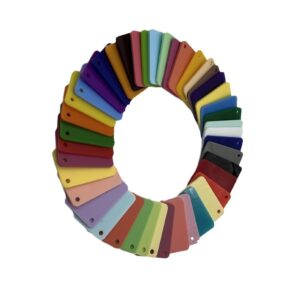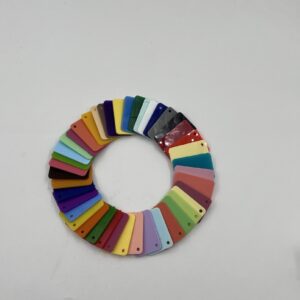Summary
Acrylic displays have emerged as a dominant choice in retail environments, celebrated for their ability to enhance product visibility and improve the overall customer experience. Known for their lightweight and portable nature, acrylic displays enable retailers to easily reposition their setups, creating dynamic shopping spaces that adapt to changing merchandising needs. The high transparency of acrylic provides an unobstructed view of showcased products, significantly increasing their visual appeal and making them more attractive to consumers. Additionally, acrylic’s shatter-resistant properties ensure durability in high-traffic areas, while its ease of maintenance contributes to long-lasting use without frequent replacements.
Notable for their customizability, acrylic displays can be molded into various shapes and colors, allowing retailers to align them closely with branding strategies. Furthermore, advancements in technology have enabled the incorporation of interactive elements, such as QR codes and augmented reality features, which enhance customer engagement and create immersive shopping experiences. This versatility is evident across different retail sectors, from experiential retail to convenience stores and supermarkets, where acrylic displays facilitate both visual merchandising and strategic product placement, ultimately driving sales and customer satisfaction.
Acrylic displays also contribute to sustainability efforts in retail, as they are recyclable and often made from recycled materials, aligning with the growing consumer demand for eco-friendly practices. This focus on sustainability not only minimizes environmental impact but also enhances brand reputation among eco-conscious consumers. As retailers increasingly prioritize sustainable solutions, the integration of acrylic displays with modern design trends and technologies signals a positive shift toward more responsible merchandising practices in the retail landscape.
Despite their many advantages, some controversies surrounding acrylic displays include concerns about the environmental impact of their production and disposal if not managed properly. Nonetheless, ongoing innovations and improved recycling practices continue to address these issues, further solidifying acrylic’s position as a preferred choice in retail display solutions.
Table of Contents
Advantages of Acrylic Displays
Acrylic displays have become a popular choice in retail environments due to their numerous advantages that enhance both product visibility and overall customer experience.
Lightweight and Portable
One of the key benefits of acrylic displays is their lightweight nature, which allows for easy movement and repositioning. This is particularly advantageous for retailers who frequently update their store layouts or participate in events such as trade shows. The ease of transport enables businesses to refresh their displays regularly, maintaining a dynamic shopping environment.
High Transparency
Acrylic offers exceptional clarity, providing an unobstructed view of the products showcased. This high transparency enhances the visual appeal of merchandise, making it more attractive to potential customers. The ability of acrylic to create the illusion of space in tighter environments further amplifies its effectiveness as a display material.
Durability and Safety
Unlike glass, acrylic is shatter-resistant, making it a durable option for high-traffic retail settings. Its robustness ensures that displays remain intact even under constant use, reducing the risk of accidents and the need for frequent replacements. Additionally, acrylic displays are easy to clean and maintain, helping to keep products looking their best.
Customizability
Acrylic can be easily molded into various shapes, sizes, and colors, allowing retailers to create bespoke display stands and holders tailored to specific product lines. This versatility enables businesses to align their displays with their branding and merchandising strategies effectively.
Environmental Advantages
Acrylic UV Printed displays not only maintain their vibrancy over time but also contribute to sustainability efforts. Their longevity means less frequent replacements, reducing waste in retail environments. By investing in durable acrylic materials, businesses can lower their environmental footprint and support green practices.
Interactive Elements
Incorporating interactive elements such as QR codes or augmented reality features into acrylic displays can significantly enhance customer engagement. These technologies provide additional product information and create immersive shopping experiences, particularly appealing to tech-savvy consumers.

Types of Acrylic Displays
Acrylic displays come in a variety of forms and configurations, making them versatile tools for retailers looking to enhance product visibility and customer interaction. These displays can be tailored to accommodate different types of merchandise and marketing strategies.
Interactive Displays
Incorporating interactive elements into acrylic displays can significantly enhance customer engagement. Features like virtual try-on stations or product demos encourage shoppers to interact with the merchandise, making the shopping experience more memorable and impactful. Custom fixtures that allow for such interactivity can be particularly beneficial in high-traffic areas of a retail environment.
Custom Stands and Cases
Custom acrylic stands and cases are particularly effective for showcasing high-tech products like smartphones and tablets. These displays allow customers to interact with the devices while ensuring they remain secure, fostering a hands-on shopping experience that can increase sales and customer satisfaction.
Display Boxes and Fixtures
Acrylic displays are available in numerous shapes and sizes, including Display Boxes, fixtures, and podiums. This variety enables retailers to create eye-catching product presentations. For instance, a plexiglass display shelf can instantly draw attention to featured items, while smaller acrylic pieces, such as u-shaped risers, are ideal for delicately displaying individual products at the front of a store.
Free-Standing and Countertop Displays
Free-standing display units (FSDUs) offer the flexibility to create focal points within a retail space. These units can be strategically placed to enhance customer flow and highlight specific products or promotions. Countertop displays, on the other hand, are designed for smaller items and are perfect for impulse purchases, providing convenient visibility near checkout areas.
Modular and Seasonal Displays
The use of modular acrylic displays allows retailers to easily reconfigure their setups according to seasonal promotions or product launches. This adaptability keeps the retail environment dynamic and engaging, while also facilitating the efficient use of space in smaller retail locations.

Applications in Various Retail Sectors
Acrylic displays have become a vital component in numerous retail sectors, serving to enhance product visibility and improve the overall shopping experience. Their versatility allows them to cater to a variety of retail formats, from pop-up shops to convenience stores and large supermarkets.
Experiential Retail
The rise of experiential retail has seen an increased demand for interactive and engaging display solutions. Retailers are leveraging acrylic displays to create unique shopping environments that combine traditional merchandising with technology. By incorporating digital elements into acrylic showcases, retailers can offer consumers a more immersive experience, thereby fostering customer engagement and enhancing brand loyalty. This trend aligns with the growing consumer preference for personalized and memorable shopping experiences.
Convenience Stores
In the convenience store segment, acrylic displays are particularly favored due to their ability to maximize space and product visibility. These stores often operate within limited square footage, necessitating display solutions that are both compact and modular. Acrylic display cases allow convenience retailers to organize their offerings efficiently while ensuring that grab-and-go meal options and refrigerated items remain easily accessible to customers. The lightweight nature of acrylic also makes it ideal for quick adjustments and seasonal promotions.
Supermarkets and Hypermarkets
Supermarkets and hypermarkets benefit significantly from acrylic displays, which are essential for showcasing a wide range of products. These retail formats require durable and versatile display solutions that can handle everything from fresh produce to electronics. Acrylic’s clear design helps to highlight product quality while maintaining an organized and visually appealing layout. Additionally, the demand for refrigerated acrylic display cases is on the rise, driven by the necessity of preserving perishable goods and keeping them in sight of customers.
Customization and Thematic Displays
Acrylic displays excel in customization, allowing retailers to adapt their merchandising strategies to align with seasonal themes and promotional campaigns. Retailers can easily switch out graphics or reposition products within acrylic fixtures to reflect holiday themes or special events, making these displays highly versatile and effective for driving sales. For instance, vibrant acrylic stands can be used to promote winter holiday gift sets, capturing shoppers’ attention during peak shopping seasons.
Visual Merchandising and Customer Engagement
Acrylic displays play a crucial role in visual merchandising by helping retailers create intuitive store layouts that enhance customer flow and dwell time. Research indicates that organized and well-lit showcases can increase foot traffic and conversion rates significantly. For example, a well-positioned acrylic showcase can draw customers into high-traffic areas, encouraging longer visits and greater engagement with products. Furthermore, the effective use of LED lighting within acrylic displays can create a premium feel, further stimulating shopper interest and interaction.

Design Considerations
Importance of Visual Appeal
Creating an engaging retail display involves thoughtful design that captures attention and tells a brand’s story effectively. A well-designed display serves as a silent salesperson, showcasing products and enhancing the shopping experience. Factors such as color, material selection, and overall structure play crucial roles in reflecting a brand’s identity and enticing customers to explore the merchandise.
Material Selection
When choosing materials for retail displays, several options are available, each with distinct advantages. Acrylic is favored for its lightweight and shatter-resistant properties, making it an excellent choice for various applications. Its ability to reproduce vibrant colors through UV printing adds to its appeal by ensuring brand colors are represented accurately. Other materials, such as wood and metal, also serve specific purposes, but acrylic’s versatility often makes it the preferred option in many retail settings. Additionally, integrating eco-friendly materials can resonate well with today’s environmentally-conscious consumers, enhancing the brand’s image.
Customization and Functionality
Customization is a growing trend in retail display design, allowing brands to create bespoke solutions tailored to their unique needs. Displays can be designed in various sizes and shapes, including thematic elements that add depth to the presentation. For instance, using acrylic blocks to elevate products can create visually interesting displays that draw attention. Furthermore, the inclusion of smart display technology, such as LED lighting and interactive features, can significantly enhance consumer engagement and showcase products in a dynamic manner.
Durability and Maintenance
Durability is a non-negotiable aspect of retail displays, particularly for those placed in high-traffic areas. Displays must withstand daily wear and tear while maintaining their visual appeal. Acrylic displays are notably easy to maintain, as they do not tarnish and require minimal effort to keep clean. This low-maintenance quality, combined with robust construction, ensures that displays continue to represent the brand effectively over time.
Compliance and Sustainability
Manufacturers must also consider regulatory compliance and sustainability in their designs. Adhering to regulations such as RoHS and REACH is crucial for ensuring that materials used in displays are safe and environmentally friendly. By prioritizing sustainable practices and materials, brands can not only reduce waste but also appeal to a growing segment of consumers who value eco-conscious choices.

Innovations and Trends in Acrylic Display Design
Acrylic displays have evolved significantly in recent years, driven by advancements in design and technology. These innovations not only enhance the aesthetic appeal of retail spaces but also improve functionality and customer engagement.
Customization and Versatility
One of the most notable trends in acrylic display design is the increased emphasis on customization. Retailers can now create unique displays tailored to specific products and brand identities. This level of personalization allows for innovative shapes and sizes, accommodating a diverse range of merchandise from jewelry to electronics. The flexibility of acrylic also means it can be molded into various designs, which enables retailers to implement modular systems that can be easily reconfigured as merchandising needs change.
Integration of Technology
The integration of technology into acrylic displays is transforming the retail landscape. Retailers are now incorporating interactive elements such as QR codes and augmented reality features that enhance customer engagement. These technologies allow consumers to access product information, reviews, or even virtual try-on experiences directly from the display. This blend of physical and digital elements not only captivates tech-savvy shoppers but also encourages longer interaction times with products.
Sustainable Practices
Sustainability has become a key consideration in the design of acrylic displays. Brands are increasingly prioritizing eco-friendly materials and manufacturing processes, responding to consumer demand for environmentally responsible practices. This includes the use of recycled acrylic and modular designs that extend the life of displays by allowing for easy updates and maintenance. As consumers become more environmentally conscious, displays that showcase a brand’s commitment to sustainability can enhance its appeal and trustworthiness.
Enhanced Visual Merchandising Techniques
Visual merchandising strategies are also evolving alongside acrylic display innovations. Retailers are utilizing strategic color palettes, lighting, and layout designs to draw attention to products and create a cohesive shopping experience. The vibrancy achievable with acrylic UV printing has opened up new possibilities for eye-catching graphics, further enhancing the visual impact of displays. Retailers can now create focal points that guide customer attention and promote impulse buying through thoughtfully designed displays that resonate with shoppers’ emotions and behaviors.
Longevity and Resilience
Another trend is the focus on the longevity and resilience of acrylic displays. Unlike traditional materials, acrylic maintains its clarity and structural integrity over time, ensuring that displays remain attractive and functional even in high-traffic environments. This durability minimizes the need for frequent replacements, reducing waste and enhancing the cost-effectiveness of using acrylic displays in retail settings.
Impact on Customer Behavior and Sales
Acrylic displays have a significant impact on customer behavior and sales in retail environments. These displays not only attract customers but also play a crucial role in retaining their interest, ultimately leading to increased dwell time within the store. By providing a compelling visual experience, retailers can foster an emotional connection with shoppers, which is essential for driving sales and customer loyalty.
Customer Satisfaction and Repeat Business
Customer satisfaction is a key indicator of a successful retail experience. Satisfied customers are more likely to return and recommend the store to others, creating a cycle of repeat business that is vital for long-term success. Retailers can measure customer satisfaction through various means, including surveys, feedback, and online reviews, enabling them to identify areas for improvement and enhance the overall shopping experience.
The effectiveness of acrylic displays can be evaluated through sales data and customer feedback. An analysis of consumer behavior has shown that well-designed displays can lead to a sales lift of 15-20% within the initial weeks of implementation. Retailers who systematically measure the performance of their displays can gain valuable insights into customer preferences, which helps in refining merchandising strategies to better meet customer needs.
Strategic Display Placement
Strategic placement of displays is crucial for maximizing sales. Research indicates that 90% of shoppers tend to turn right upon entering a store, making the right-side wall an ideal location for wall cases to enhance visibility and drive sales. Additionally, positioning high-value items, such as designer handbags in trophy cases near decision points, can prompt impulse purchases, further increasing overall sales performance. A case study involving a Richmond clothing retailer demonstrated a 16% increase in sales after strategically rearranging their store layout and optimizing display placements.
Leveraging Data and Personalization
Incorporating data analytics into display strategies allows retailers to better understand shopper behavior and tailor their merchandising efforts accordingly. Personalized displays that resonate with the target audience can significantly influence purchasing decisions, as 93% of consumers base their buying choices on visual stimuli. Furthermore, storytelling and themes in displays enhance customer engagement, making the shopping experience more memorable and effective.
Sustainability of Acrylic Displays
Acrylic displays are not only favored for their aesthetic appeal and durability but also for their sustainability attributes. As eco-consciousness grows among consumers and retailers alike, acrylic offers several environmental advantages that contribute to a more sustainable retail ecosystem.
Recyclable Material
One of the primary sustainability benefits of acrylic is that it is a recyclable material. This characteristic allows acrylic displays to have a second life once they are no longer needed, reducing waste in landfills. By opting for recyclable materials, retailers not only support sustainable practices but also appeal to environmentally conscious consumers, enhancing their brand reputation in a competitive market.
Reduced Carbon Footprint
The sustainability movement is prompting manufacturers to adopt greener practices. This includes sourcing recycled acrylic, which retains the same properties as virgin acrylic, such as strength and clarity, ensuring that the quality of displays is not compromised. Additionally, the production processes for acrylic can be optimized to minimize waste, further contributing to a reduced carbon footprint. Retailers can therefore provide eco-friendly solutions while maintaining the visual appeal of their displays.
Market Trends and Technological Advancements
The growing demand for sustainable products is reshaping market trends in the retail sector. Retailers are increasingly integrating sustainable materials like recycled acrylic into their merchandising strategies, which not only supports environmental goals but also meets consumer expectations. Furthermore, advancements in technology, such as the use of LED lighting in acrylic displays, enhance the dynamism of product presentations, promoting customer engagement without sacrificing sustainability. This integration of technology with eco-friendly materials signals a positive trend towards sustainable retail solutions.

















